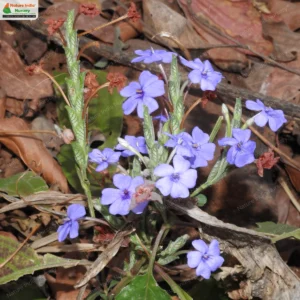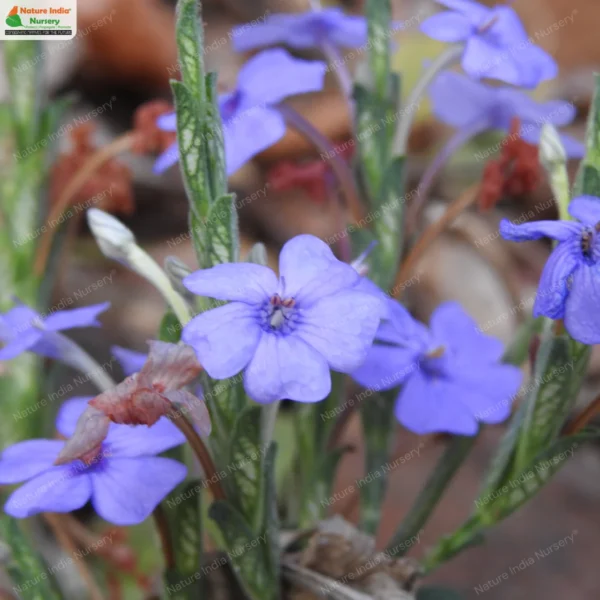Eranthemum roseum, commonly known as blue eranthemum, rosy eranthemum, or locally as dasmuli (दसमुळी) and jangali aboli (जंगली अबोली), is a perennial shrub native to the Western Ghats of India. It typically grows to a height of 0.5–2 meters, exhibiting a bushy, upright habit with tuberous, spindle-shaped roots that are often produced in clusters-hence the name “dasmuli,” meaning “ten roots”. The leaves are oblong-lanceolate, 12–20 cm long and 3.5–7.5 cm wide, with an acuminate apex and tapering base, and are lineolate on both surfaces. The plant is cultivated for its attractive foliage and flowers, which are blue when fresh, turn rosy as they age, and become brown on drying.
The flowers appear in terminal spikes and are noted for their ornamental value. The roots are yellowish-brown, aromatic, slightly bitter, and smooth, with a characteristic spindle shape and tapering ends. The plant is also recognized for its use in traditional medicine and is included in some Ayurvedic formulations.
Habitat
Eranthemum roseum is native to the seasonally dry tropical biome of the Western Ghats and is also found in deciduous forests and scrub jungles across western and southern India, including Maharashtra, Chhattisgarh, and the Satpuda valley. It thrives in forested areas and is sometimes cultivated in gardens for its ornamental and medicinal value.
Planting and Care
- Light: Prefers partial shade to filtered sunlight, mimicking its natural forest habitat.
- Soil: Grows best in well-drained, fertile soils with moderate organic content.
- Watering: Requires regular watering during the growing season, but avoid waterlogging.
- Propagation: Propagated by seeds or division of tuberous roots.
- Maintenance: Prune to maintain bushy growth and remove spent flower spikes to encourage further blooming.
Additional Information
- Ornamental Use: Valued for its blue to rosy flowers and attractive foliage, making it suitable for gardens and landscaping.
- Medicinal Properties: Roots are traditionally used in remedies for leucorrhoea, as a tonic for pregnant cattle, and in Ayurvedic massage oils and tonics.
- Phytochemistry: Contains saponin glycosides, carbohydrates, proteins, and steroidal sapogenins; roots have notable foaming and haemolytic activity.
- Cultural Significance: Known as “dasmuli” due to its multiple tuberous roots, which are significant in local herbal traditions.
- Distribution: Endemic to the Western Ghats but also found in other parts of India and Bangladesh.














